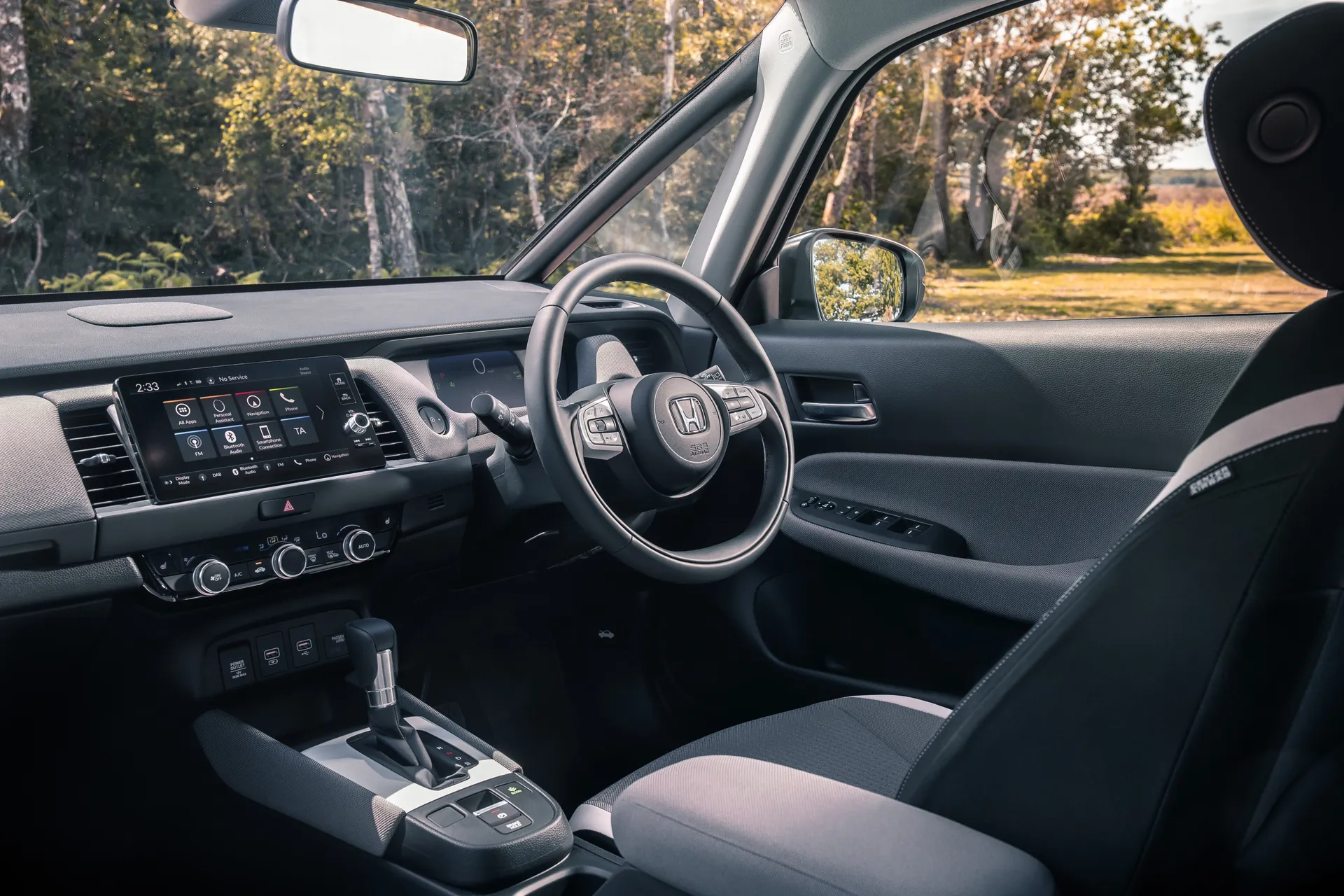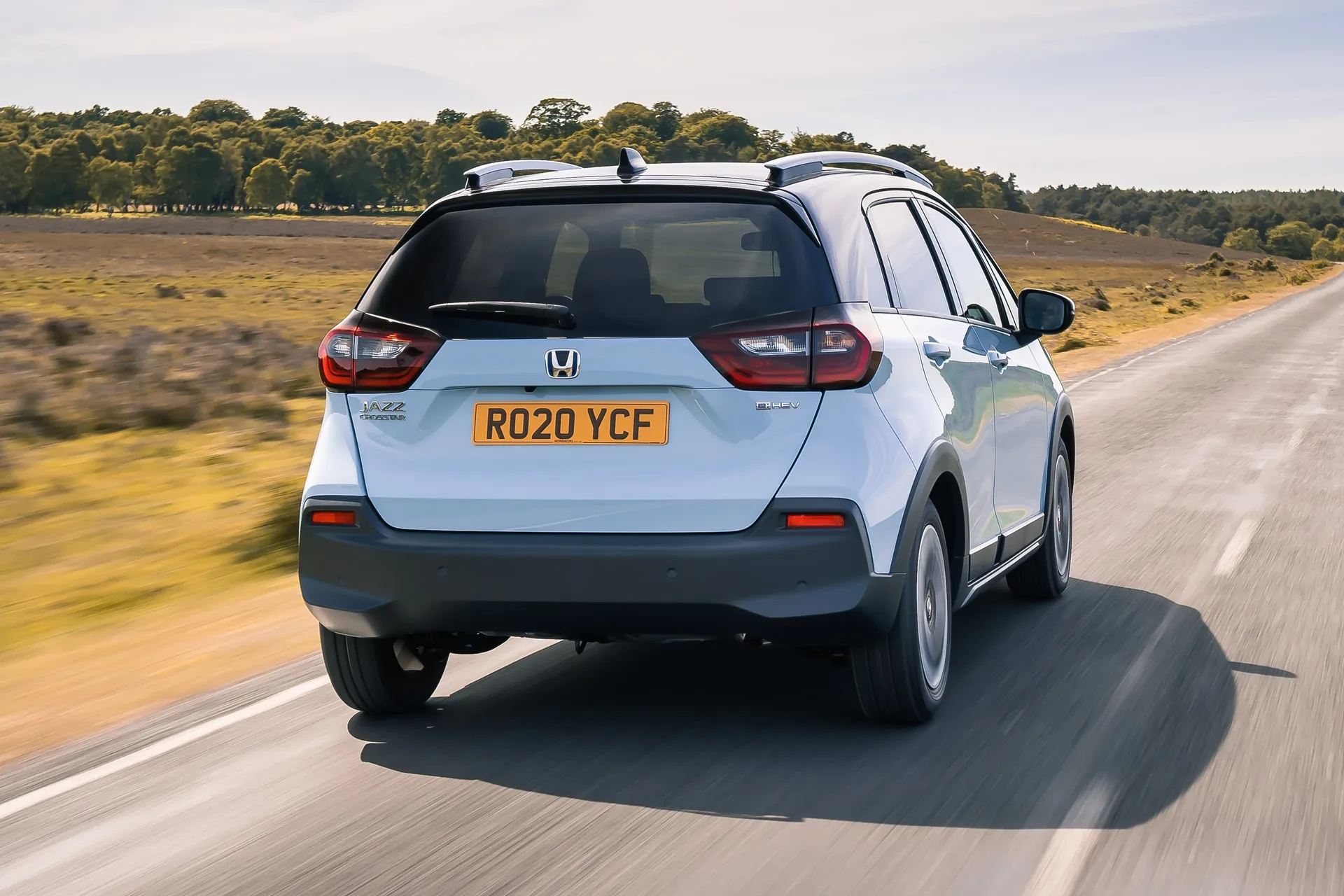Honda Jazz Crosstar Review 2025: Price, specs & boot space
Written by Andrew Brady
Quick overview
Pros
- Looks a bit more interesting than the standard Jazz
- Water-repellent upholstery could prove useful
- The sound system is pretty good
Cons
- Pricier than a normal (already quite expensive) Jazz
- Not that different to a normal Jazz
- No more comfortable or capable off-road
Overall verdict on the Honda Jazz Crosstar
"The standard Honda Jazz is an excellent car, with low running costs and a versatile interior. The Jazz Crosstar builds on that with rugged styling and some extra equipment as standard. Its faux-SUV design gives it some appeal but, in truth, its relatively high price tag makes it tough to justify. Who needs a Jazz with extra ground clearance, anyway?"

Ever found yourself wishing the Honda Jazz was a little more… rugged? Well, good news. The brand’s given it the off-roader treatment - well, sort of, as this review will discuss. It’s called the Crosstar and it’s based on the excellent new Honda Jazz Hybrid.
The Honda Jazz Crosstar takes a similar approach to the Dacia Sandero Stepway and short-lived Hyundai i20 Active, cashing in on the SUV and crossover craze by adapting some of the design traits of those popular cars - if none of the off-road ability and additional practicality.
Unlike other jacked-up small cars, however, the Jazz’s impressive versatility means it could also be considered an alternative to crossover SUVs like Honda’s own HR-V, the Citroen C3 Aircross, Volkswagen T-Cross and Renault Captur.
It builds on the Jazz Advance model, meaning it’s well equipped (and a bit pricey) as standard. Upgrades include bespoke front and rear bumpers, a unique grille, black side sills and roof rails. It sits ever-so-slightly higher than the standard car, but don’t be fooled by the chunky appearance. There’s no four-wheel-drive system, and this definitely isn’t an off-roader.
The inside is surprisingly similar to the standard Jazz, aside from water-repellent fabric seats, which are heated, and there's a heated steering wheel, too.
And, just like the standard car, we can’t overemphasise how practical the Crosstar is. There’s plenty of room for four tall adults, with comfortable seats and an airy cabin. It's not quite as airy as the Dacia Sandero Stepway but it's not claustrophobic either, and the trick rear seats mean there’s loads of luggage space when required. That is, of course, the same as the standard Jazz.
It’s also a hybrid model, just like the standard… you get the message. It combines a 1.5-litre petrol engine with a lithium-ion battery pack, a single-speed CVT gearbox and two electric motors.
The result is hugely impressive efficiency, particularly when compared to the aforementioned soft-roaders. Officially, it’ll return 58.9mpg - which is only marginally thirstier than the standard Jazz, and our test drive suggests this is actually feasible in the real world.
It’s brilliant around town, helped by the high seating position and huge front windscreen providing a good view of the road ahead. There’s a tiny turning circle, light steering and a standard reversing camera - all of which add up to make the Jazz Crosstar great fun for threading through traffic.
It’s also surprisingly refined at high speeds, although be warned - this isn’t a car that smooths out bumpy road surfaces. You might expect it to be softer than the standard Jazz (which itself is on the firm side), but it isn’t. Hit a big pothole and your passengers will wince.
There’s quite a lot to like about the Jazz Crosstar. It drives well, has a modern interior and does an excellent impression of a much bigger car. But, well, so does a conventional Jazz, and that’s cheaper. Just how much do you want water-repellent seats and some extra exterior garnishing?
Looking for a used car for sale? We've got 100s of Honda Approved Used Cars for Sale for you to choose from, including a wide range of Honda Jazz Crosstar cars for sale.
Is the Honda Jazz Crosstar right for you?
What’s the best Honda Jazz Crosstar model/engine to choose?
What other cars are similar to the Honda Jazz Crosstar?
Comfort and design: Honda Jazz Crosstar interior
"The Jazz Crosstar has essentially the same interior as the normal Jazz. That's no bad thing, but we'd have liked some more distinctiveness to mark it out."

While the outside of the Jazz Crosstar has been given a rugged makeover, there’s little inside to differentiate it from the standard car. We’d love to see some wood trim and rubber floor mats… OK, maybe ‘love’ is too strong a word.
There is water-repellent upholstery in case the excitement of the Jazz Crosstar gets a little too much, but we actually prefer Jazz Advance's half leather.
These gripes aside, the Jazz Crosstar does have a very modern-looking cabin. We like its fabric-covered dash, and the large windscreen means it feels light and airy, like a conservatory. Wide, well-cushioned seats mean it’s a comfy choice, too. You can’t get adjustable lumbar support, but we found the seats to be pretty supportive for long journeys.
Like the standard Jazz, the Crosstar gets a digital dash in place of old-school dials. These are overloaded with information - from the outside temperature to whether your car's running on electricity or petrol. The current speed is displayed in large, clear font but it’s all a bit overwhelming at first, particularly as older Jazz models are known for being utterly simple to use.
Quality and finish
Infotainment: Touchscreen, USB, sat-nav and stereo in the Honda Jazz Crosstar
Space and practicality: Honda Jazz Crosstar boot space
Handling and ride quality: What is the Honda Jazz Crosstar like to drive?
"You'd be hard-pushed to notice any real difference to the Jazz Crosstar's driving experience over the regular Jazz."

A bonus of beefed-up small cars like the Jazz Crosstar and alternatives like the Dacia Sandero Stepway and Honda HR-V is usually a softer, more compliant ride. However, while the Jazz Crosstar rides slightly higher than the normal Jazz, you’re not going to notice a perceivable improvement in ride quality.
Just like the standard car, it’ll thump a bit over bumps in the road - the Jazz has always been on the firm side for the small car class. If you’re looking for a car that hops (rather than crashes) over broken road surfaces, we’d recommend looking at the Citroen C3 Aircross instead.
On the plus side, the Jazz Crosstar handles just as well as the standard car. It doesn’t lean too much in bends, and it feels like a big, grown-up car on open roads. You’re not going to be intimidated by other traffic on the motorway.
It’s also brilliant around town. The turning circle is impressive - wind on the steering and it’ll turn 90 degrees in a tiny gap. If you plan on doing this regularly, though, we’d recommend the standard Jazz - wannabe-taxi drivers will find it has a slightly tighter turning circle.
Forward visibility is good, thanks to a huge windscreen and ultra-thin pillars. The standard-fit parking sensors are essential for judging the front of the bonnet, while a reversing camera (and usefully large door mirrors) helps when backing into a space.
It's 30mm taller than a standard Jazz but is still front-wheel drive, meaning it's not exactly a bonafide offroader. There aren’t any gimmicky electronic systems to help you get out of a muddy field either, so we wouldn't recommend taking it through the Amazon Rainforest.
What engines and gearboxes are available in the Honda Jazz Crosstar?
Refinement and noise levels
Safety equipment: How safe is the Honda Jazz Crosstar?
MPG and fuel costs: What does a Honda Jazz Crosstar cost to run?
"The Crosstar’s fuel economy does take a slight knock compared to the standard Jazz, officially returning 58.9mpg (compared to the Jazz Hybrid’s 62.8mpg)."

The consequence of chunky styling add-ons and a raised ride height means the Honda Jazz Crosstar is less capable at slipping through the air than the standard Jazz. That means a slight fuel economy penalty.
It's not severe: officially the Crosstar returns 58.9mpg (compared to the Jazz Hybrid’s 62.8mpg). The difference in the real world will be negligible though and, unlike turbocharged rivals, these figures should be fairly achievable. When driving the Crosstar, we saw around 60 mpg on the trip computer. Consider, too, that full-sized SUVs will be more compromised still in terms of fuel economy.
Honda Jazz Crosstar reliability and warranty
Honda Jazz Crosstar insurance groups and costs
VED car tax: What is the annual road tax on a Honda Jazz Crosstar?
Honda Jazz Crosstar price
"It’s not cheap, the Honda Jazz Crosstar. A new one will set you back more than £29,650; that's nearly £14,000 more than an entry-level Dacia Sandero Stepway.

You can pick up an early EX car with nearly 80,000 miles for around £14,000. If a newer Advance model is what you seek, these are priced from £20,000.
Trim levels and standard equipment
Ask the heycar experts: common questions
Is the Honda Jazz Crosstar a self-charging hybrid?
What's the difference between a Honda Jazz and a Crosstar?
Is the Honda Jazz Crosstar worth it?
Honda Jazz Crosstar cars for sale on heycar
Honda Jazz Crosstar1.5 i-MMD Hybrid Crosstar Advance 5dr eCVT
20255,332 milesHybrid£369 mo£24,739
Fair priceTS183SEHonda Jazz Crosstar1.5 i-MMD Hybrid Crosstar EX 5dr eCVT
202215,069 milesHybrid£432 mo£19,580
NE5 2LAHonda Jazz Crosstar1.5 i-MMD Hybrid Crosstar Advance 5dr eCVT
202320,523 milesHybrid£290 mo£21,450
Good priceRH108JGHonda Jazz Crosstar1.5 i-MMD Hybrid Crosstar EX 5dr eCVT
20232,589 milesHybrid£284 mo£21,000
Fair pricePO215EHHonda Jazz Crosstar1.5 i-MMD Hybrid Crosstar EX 5dr eCVT
202215,200 milesHybrid£263 moor £19,450£19,850
£400 offGU33LD
Honda Jazz Crosstar Alternatives
Get our latest advice, news and offers
Keep me updated by email with the latest advice, news and offers from heycar.
By submitting you agree to our privacy policy



